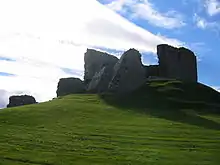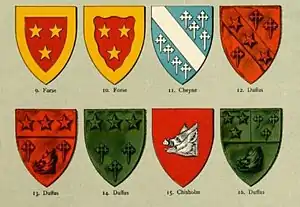Lord Duffus
The title Lord Duffus was created by Charles II in the Peerage of Scotland on 8 December 1650 for Alexander Sutherland. He was a descendant of the 4th Earl of Sutherland, who fell in battle in 1333. The title is now extinct, although there may be male-line Sutherlands descended from earlier lairds of Duffus.

In 1734, the 3rd Lord was attainted and the lordship was forfeited. His son Eric tried but failed to get a reverse of the attainder. His son James Sutherland of Duffus got the attainder reversed, and was restored to the lordship as 4th (titular 5th) Lord Duffus on 25 May 1826. The last two Lords Duffus were also baronets, of Hempriggs in the County of Caithness (3rd and 4th). The lordship became extinct on the death of the 6th (titular 7th) Lord Duffus on 28 August 1875.
Origins of the Duffus sept

The Sutherland family of Duffus descended from Nicholas Sutherland, only brother of William de Moravia, 5th Earl of Sutherland (d. 1370), and younger son of Kenneth de Moravia, 4th Earl of Sutherland. The village of Duffus is outside of the county of Sutherland. Some of the Sutherland of Duffus family may have assumed the surname Duffus, which was the family title instead of the surname Sutherland.[2]
Ancestors of the Lords Duffus
These are the early ancestors of the Lords Duffus.[2]
- Kenneth de Moravia, 4th Earl of Sutherland (Kenneth Sutherland).
- Nicholas Sutherland, 1st of Duffus (younger son of Kenneth).
- John Sutherland, 2nd of Duffus.
- Alexander Sutherland, 3rd of Duffus and Torboll (d. c.1484) (son of Henry Sutherland of Torboll, younger son of Nicholas, 1st of Duffus)
- William Sutherland of Quarrywood, later 4th of Duffus (d. c.1513) (son of William Sutherland of Berriedale, son of Alexander, 3rd of Duffus)
- William Sutherland, 5th of Duffus. (d. c.1529)
- William Sutherland, 6th of Duffus. (d. c.1530)
- William Sutherland, 7th of Duffus.
- Alexander Sutherland, 8th of Duffus. (1534 - 1579)
- William Sutherland, 9th of Duffus. (d. 1616)
- William Sutherland, 10th of Duffus. (d. 1626)
Lords Duffus (1650)
- Alexander Sutherland, 1st Lord Duffus (d. 1674) (son of William Sutherland, 10th of Duffus)
- James Sutherland, 2nd Lord Duffus (d. 1705) who had issue four sons (Kenneth, 3rd Lord, Sir James Dunbar, 1st Baronet and two others) and one daughter.
- Kenneth Sutherland, 3rd Lord Duffus (d. 1734) (attainted and forfeit 1734) for his part in the 1715 uprising. He fled to Sweden, where he married a Swedish lady, Christina Sjöblad, by whom he had:
- Eric Sutherland, 4th Lord Duffus (1710-1768) (not restored, but counted), married his first cousin Elizabeth, third daughter of Sir James Dunbar of Hempriggs, 1st Baronet by his wife Elizabeth Dunbar, daughter and heiress of Sir William Dunbar of Hempriggs, 1st Baronet of Northfield.[3] They were parents of the 5th Lord Duffus, another son (who died issueless), and three daughters including an eldest daughter Elizabeth, wife firstly of Captain Alexander Sinclair, son of Sir William Sinclair of Keiss; secondly Charles Sinclair of Olrig (by whom one son and one daughter) and thirdly, in 1772, the Reverend James Rudd, rector in Yorkshire.[4]
- James Sutherland, 5th Lord Duffus (1747-1827) (restored 1826), who died unmarried. He eloped in December 1771 with the seventeen-year-old Lady Mary Hay, the daughter of the Earl of Erroll, Hereditary Lord High Constable of Scotland, and the wife of Major-General John Scott; she was divorced by her husband, Sutherland's colonel at the time. He abandoned her, never married, and recognized 10 illegitimate children in his will. However, he is said to have at least 60 illegitimate children.[5] The barony was claimed by the nearest heir male (and also by the 5th Lord's nephew):
- Benjamin Dunbar, 6th Lord Duffus, 3rd Baronet of Hempriggs (1761-1843), grandson of Sir James Sutherland-Dunbar of the 5th Lord Duffus[6] This man, together with his son, unsuccessfully petitioned the House of Lords in 1838 to be granted the title and the seat in the House of Lords, but the petition was not acted upon. (A challenge was mounted by the Rev. Eric Rudd, apparently the sole surviving nephew of the late 5th Lord.[7] He was the son of Elizabeth Sutherland by her third husband Rev. James Rudd (d. 23 February 1827, aged 83)[8] He was succeeded de facto by his son:
- George Sutherland Dunbar, 7th Lord Duffus (1799-1875) (extinct 1875) used the title of 7th Lord Duffus, but was also known as Sir George Dunbar of Hempriggs, 4th Baronet.[9]
See also
Notes
Information on the Lords Duffus was obtained in part from the Sutherland history (below), and from Elinor Glyn (1955), a memoir by her grandson Anthony Glyn. Glyn and her sister Lucy, Lady Duff-Gordon were born Sutherlands, descended from David Sutherland, Laird of Cambusavie, allegedly a son of Alexander Sutherland, a younger brother of the Jacobite 3rd Lord Duffus, who is described in The Scots Peerage as having died without issue. The fact that the 6th Lord Duffus inherited in 1827 over the now Canadian Sutherlands, who sold their estates in the 1770s to the Earl of Sutherland, probably means that the relationship was more distant, or if the same, that the Laid of Cambusavie was illegitimate.
References
- Balfour Paul, J 1906 & 1911 The Scots Peerage. Edinburgh
- Sutherland of Duffus Family Tree. duffus.com Retrieved on December 28, 2012.
- The Scots Peerage. Also see "The Lost Lordship of Duffus"
- A Rev. Eric Rudd, son of Elizabeth Sutherland by her third marriage, unsuccessfully claimed the lordship of Duffus around 1838. The son of Elizabeth Sutherland by her second husband Charles Sinclair died in 1772, and there were also three daughters (per The Scots Peerage) of whom Finella Sinclair, later Mrs Cullen, was living in 1772, when she inherited an estate from her deceased brother. These daughters of course would fall behind their half-brother Rev. Eric Rudd in succession to heirs whatsoever. The second daughter of Eric, de jure 4th Lord Duffus, was Charlotte, mother of the 12th Earl of Caithness.
- "Re: [SUT] Capt. James SUTHERLAND" SCT-SUTHERLAND-L Archives, 17 February 2002, quoting a story from Sutherland: A Fightin.g Clan by Malcolm Sutherland (Avon Books, London, first pub. 1996). The author describes James as "a scallywag (see footnote 140)." [pp. 174-175] The author goes on to say "he died a bachelor and the Duffus title passed, not without dispute, to his cousin, Sir Benjamin Sutherland Dunbar of Hempriggs." The discrepancy between Anthony Glyn's romantic version of an unmarried couple living together and producing 10 children together and this version is immense.
- Anthony Glyn (1955) mistakenly says that the 6th Lord Duffus was son of the sister of the 3rd Lord Duffus; he was in fact grandson of the younger brother of the 3rd Lord.
- 'House of Lords Journal Volume 64: 15 May 1832', Journal of the House of Lords: volume 64: 1831-1832 "Duffus Peerage, E. Rudd's Petition respecting", pp. 208-210. URL: http://www.british-history.ac.uk/report.aspx?compid=19313 Date accessed: 15 March 2009.
- The Gentleman's magazine, Google Books, Retrieved 15 March 2009.
- One source "The Lost Lordship of Duffus" claims that due to the Rudd challenge, the 7th Lord never used the title, and chose to be known as a baronet. This however is contradicted by thepeerage entry on the 7th Lord.
- The Scots Peerage (archived version).
- Daniel J.J. Sutherland. "A Short History of Clan Sutherland, The Families of Sutherland, Forse and Duffus, 12th-19th century". Retrieved 15 March 2009.